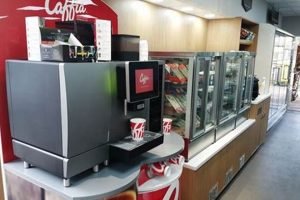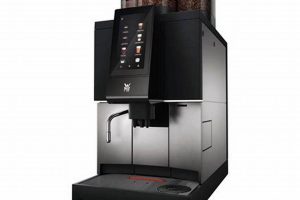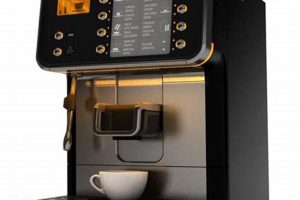A device designed to brew coffee, manufactured by Elektra, characterized by its distinctive aesthetics and engineering, is a staple in both commercial and domestic settings. These devices are recognized for their craftsmanship and ability to produce high-quality espresso, offering a range of models to suit different needs and preferences. For instance, some models prioritize ease of use for home baristas, while others are built for high-volume service in cafes.
The significance of such a device lies in its ability to consistently deliver flavorful espresso, impacting the overall coffee experience. Elektra’s history is steeped in tradition, contributing significantly to the evolution of espresso machine technology. The brand is often associated with prestige and quality, enhancing the perceived value of the coffee served or prepared using their equipment.
The following sections will delve into specific models, features, maintenance requirements, and the broader impact of Elektra’s contributions to the coffee industry, providing a detailed overview for potential buyers and enthusiasts alike.
Elektra Coffee Machine
The following tips are designed to optimize the performance and longevity of Elektra coffee machines, ensuring consistent espresso quality and minimizing potential downtime.
Tip 1: Water Quality Management: Employ filtered water to prevent scale buildup within the boiler and group heads. Mineral deposits negatively impact temperature stability and extraction efficiency. Regularly assess water hardness and adjust filtration accordingly.
Tip 2: Backflushing Procedure: Implement a daily backflushing routine using a suitable espresso machine cleaning detergent. This process removes coffee oils and residue from the group head, preventing blockage and maintaining optimal flow.
Tip 3: Group Head Gasket Replacement: Inspect and replace group head gaskets every six to twelve months, depending on usage frequency. Worn gaskets compromise the seal, leading to pressure loss and inconsistent extraction.
Tip 4: Boiler Pressure Monitoring: Regularly monitor boiler pressure to ensure it remains within the manufacturer’s specified range. Fluctuations in pressure can indicate a malfunctioning pressurestat or other issues requiring professional attention.
Tip 5: Temperature Calibration: Verify and calibrate brew temperature periodically using a Scace device or similar tool. Accurate temperature control is crucial for optimal flavor extraction and consistent results.
Tip 6: Portafilter Maintenance: Maintain clean portafilters and baskets. Remove coffee grounds immediately after each extraction and periodically deep clean to eliminate residue buildup. Ensure the portafilter handle is securely tightened.
Tip 7: Professional Servicing: Schedule routine professional servicing with a qualified technician. Early detection and repair of minor issues prevent potentially costly and disruptive breakdowns.
Adhering to these maintenance and operational guidelines will contribute to the consistent performance and extended lifespan of Elektra coffee machines, ensuring optimal espresso quality and minimizing operational disruptions.
The subsequent sections will address specific model features and troubleshooting common operational issues.
1. Design and Aesthetics
Elektra coffee machines are distinguished by their deliberate fusion of functional engineering and visually compelling design. This emphasis on aesthetics is not merely superficial; it directly influences the perception of the brand and the overall coffee-making experience. The art deco influences present in many Elektra models, particularly the Belle Epoque series, serve as a prime example. The visible copper and brass components, combined with flowing lines and intricate detailing, transform the machine from a purely utilitarian appliance into a statement piece. This design philosophy elevates the act of preparing coffee, contributing to a sense of ritual and craftsmanship.
The impact of design extends beyond mere visual appeal. A well-designed machine can improve usability and ergonomics. The placement of controls, the angle of the portafilter handle, and the visibility of gauges all contribute to the efficiency and comfort of the barista. Furthermore, the use of high-quality materials, such as polished stainless steel and durable polymers, not only enhances the aesthetic appeal but also signifies longevity and reliability. Consider the Elektra Microcasa Lever, a compact model that exemplifies the brand’s commitment to both form and function. Its polished finish and lever-operated mechanism contribute to a distinct and engaging user experience.
In conclusion, the design and aesthetics of Elektra coffee machines are integral to their identity and market positioning. The deliberate blending of form and function elevates the product beyond a simple appliance, creating a visual and tactile experience that enhances the perceived value and enjoyment of the coffee-making process. This focus on aesthetics is not merely cosmetic; it reflects a commitment to quality and craftsmanship that contributes to the brand’s enduring appeal.
2. Espresso Quality
Espresso quality, defined by characteristics such as crema consistency, body, flavor complexity, and aromatic profile, is intrinsically linked to the performance capabilities of espresso machines. The following aspects detail how the design and function of Elektra coffee machines directly influence the attainment of these quality metrics.
- Temperature Stability
Consistent water temperature throughout the brewing process is paramount for optimal extraction. Elektra machines, particularly those with PID (Proportional-Integral-Derivative) controllers, are engineered to maintain precise temperature stability. Fluctuations in temperature can lead to under-extraction (sour taste) or over-extraction (bitter taste). The design of the boiler and heating element within Elektra machines plays a critical role in this temperature regulation.
- Pressure Profiling
The application of consistent and appropriate pressure is essential for drawing out the desired flavors and oils from the coffee grounds. Certain Elektra models offer manual lever operation, allowing baristas to directly control the pressure applied during extraction. This control enables nuanced pressure profiling, which can be used to tailor the espresso’s characteristics to specific coffee blends and roast levels. The mechanics of the lever system and the quality of the seals contribute to the precision and consistency of pressure delivery.
- Water Quality
The quality of the water used directly impacts the taste and aroma of the espresso. Elektra machines, while not directly filtering water, benefit from proper water filtration systems used externally. Mineral content and pH levels can influence extraction efficiency and flavor perception. Maintaining water hardness within acceptable ranges, as recommended by Elektra, is crucial for both espresso quality and machine longevity.
- Group Head Design
The design of the group head, including its thermal mass and water distribution system, contributes to even saturation of the coffee grounds. Elektra machines utilize group heads designed for optimal heat retention and uniform water flow. This design minimizes channeling and ensures consistent extraction across the entire puck of coffee, leading to a more balanced and flavorful espresso.
These interconnected elements temperature stability, pressure profiling, water quality management, and group head design collectively contribute to the ability of Elektra coffee machines to produce high-quality espresso. The interplay of these factors determines the final cup profile, influencing the sensory experience and overall satisfaction. The careful consideration given to these aspects in the engineering and construction of Elektra machines underscores the brand’s commitment to delivering consistent and exceptional espresso.
3. Build Quality
Build quality, encompassing material selection, manufacturing precision, and component durability, significantly influences the performance and longevity of Elektra coffee machines. The correlation between robust construction and operational reliability is evident in the extended lifespan observed in well-maintained Elektra units. For instance, models employing brass boilers and stainless steel frames demonstrate resistance to corrosion and thermal stress, common causes of failure in espresso machines. The precision engineering inherent in these machines reduces the likelihood of leaks and mechanical malfunctions, directly affecting the consistency of espresso extraction. Inferior construction, conversely, would compromise temperature stability and pressure regulation, leading to inconsistent and substandard results.
The impact of build quality extends beyond basic functionality. The use of high-quality components, such as robust heating elements and durable pump systems, ensures consistent performance over time. This reliability is particularly crucial in commercial settings where equipment downtime translates directly into lost revenue. Elektra’s reputation for durability stems from a commitment to using premium materials and rigorous quality control throughout the manufacturing process. The difference between a machine built with mass-produced, low-grade parts and an Elektra unit constructed with precision-engineered components is readily apparent in both performance and lifespan. Examples include the longevity of Elektra’s lever machines, many of which remain in service for decades due to their robust mechanical design and high-quality materials.
In summary, build quality serves as a foundational element of the Elektra coffee machine’s value proposition. It directly impacts operational reliability, espresso quality, and overall lifespan. The use of premium materials and meticulous construction techniques contributes to the brand’s reputation for durability and performance, making it a preferred choice for both discerning home baristas and demanding commercial environments. The long-term cost-effectiveness of Elektra machines is often justified by their extended operational life and reduced maintenance requirements, directly attributable to their superior build quality.
4. Operational Reliability
Operational reliability, the ability of equipment to perform its intended function consistently and without failure over a specified period, is a critical attribute of Elektra coffee machines. The degree to which these machines exhibit operational reliability directly impacts the efficiency and profitability of businesses that rely on them, as well as the satisfaction of individual users. Factors contributing to operational reliability in Elektra machines include robust design, high-quality components, and adherence to recommended maintenance schedules. Failures, stemming from inadequate maintenance or component defects, result in downtime, repair costs, and potential revenue loss.
The design of Elektra machines incorporates features intended to enhance operational reliability. For instance, the use of durable materials like brass and stainless steel in key components, such as boilers and group heads, mitigates the risk of corrosion and mechanical stress. Furthermore, the implementation of safety mechanisms, such as over-pressure valves and thermal cut-offs, prevents catastrophic failures and protects the equipment from damage. However, even well-designed machines require regular maintenance to sustain operational reliability. Scale buildup, resulting from hard water, can impede heating efficiency and damage internal components. Proper water filtration and regular descaling are essential preventative measures. Similarly, worn gaskets and seals can lead to leaks and pressure loss, compromising espresso quality and potentially damaging other components. Timely replacement of these parts is crucial for maintaining optimal performance.
In conclusion, operational reliability represents a core value proposition of Elektra coffee machines. The interplay between robust design, quality components, and diligent maintenance dictates the machine’s ability to consistently deliver high-quality espresso over its lifespan. While inherent design features contribute significantly to operational reliability, adherence to recommended maintenance protocols is paramount for maximizing uptime and minimizing the risk of costly breakdowns. This commitment to both engineering excellence and preventative maintenance ensures the long-term performance and profitability associated with Elektra equipment.
5. Historical Significance
The historical significance of Elektra coffee machines stems from the company’s enduring presence in the evolution of espresso technology and design. Its contribution to the development and popularization of espresso culture is a tangible element of the modern coffee industry.
- Early Innovation in Espresso Technology
Elektra was among the pioneering manufacturers that shaped early espresso machine designs. Its innovations in lever-operated machines, boiler technology, and temperature control mechanisms set industry standards. These advancements directly influenced the methods used to extract espresso, impacting the flavor profiles and brewing techniques that define espresso-based beverages. The company’s commitment to engineering advancements allowed for greater control and precision in the brewing process.
- Influence on Espresso Machine Aesthetics
Elektra’s impact extends beyond functionality to aesthetics. The design elements incorporated into its machines, particularly the art deco influences prominent in models like the Belle Epoque, elevated espresso machines from utilitarian tools to design statements. These design choices influenced the visual appeal of cafes and contributed to the overall perception of espresso as a premium beverage. This focus on aesthetics fostered a culture around the presentation and appreciation of coffee.
- Role in Popularizing Espresso Culture
By producing reliable and visually appealing espresso machines, Elektra played a role in the expansion of espresso culture beyond Italy. The machines’ presence in cafes worldwide facilitated the widespread adoption of espresso-based drinks. This international dissemination contributed to the standardization of espresso preparation techniques and the global appreciation of espresso as a distinct culinary experience. The company’s global reach helped shape the international coffee landscape.
The historical trajectory of Elektra coffee machines underscores the brand’s sustained commitment to innovation and design within the coffee industry. Its contributions extend from technological advancements to aesthetic considerations, playing a pivotal role in the popularization of espresso culture on a global scale. The longevity and recognition of the Elektra brand are testaments to its enduring influence on the landscape of modern coffee consumption.
Frequently Asked Questions
The following questions address common inquiries and misconceptions regarding Elektra coffee machines, providing clarity and guidance for prospective buyers and current owners.
Question 1: What are the primary factors contributing to the elevated cost of Elektra coffee machines?
The cost reflects a combination of factors: the use of high-quality materials such as brass and stainless steel, precision engineering in manufacturing processes, and the brand’s established reputation for durability and performance. Design aesthetics, particularly in models like the Belle Epoque, contribute to the premium price point.
Question 2: How does the maintenance regimen for Elektra machines differ from that of other espresso machine brands?
While basic maintenance principles apply universally, Elektra machines require diligent attention to water quality management due to the potential for scale buildup in brass boilers. Regular descaling and the use of filtered water are paramount. Certain models with lever mechanisms may require specialized maintenance procedures.
Question 3: What is the expected lifespan of an Elektra coffee machine, assuming proper maintenance?
With consistent and meticulous maintenance, an Elektra machine can provide reliable service for decades. Commercial units typically last between 10 to 15 years, while home models can exceed 20 years. Lifespan is contingent on water quality, usage frequency, and adherence to recommended service intervals.
Question 4: Are replacement parts readily available for older Elektra models?
Replacement parts for many older Elektra models remain accessible through specialized distributors and online retailers. However, sourcing components for extremely vintage machines may require specialized knowledge and research.
Question 5: What distinguishes lever-operated Elektra machines from automatic models in terms of espresso quality?
Lever-operated machines afford the user greater control over pressure profiling during extraction, allowing for nuanced adjustments to flavor and body. However, this requires skill and experience. Automatic models prioritize consistency and ease of use, potentially sacrificing some degree of control.
Question 6: Is professional installation required for Elektra coffee machines?
Professional installation is highly recommended, particularly for commercial units, to ensure proper plumbing and electrical connections. Incorrect installation can void warranties and compromise the machine’s performance and safety.
These answers provide a foundational understanding of key considerations related to Elektra coffee machines, assisting in informed decision-making.
The next section will explore troubleshooting common operational issues and identify available resources for technical support.
Conclusion
The preceding analysis has explored various facets of the Elektra coffee machine, encompassing its design, operational characteristics, build quality, historical significance, and maintenance requirements. These elements contribute to the understanding of its position within the market and its impact on espresso preparation.
Ultimately, the continued relevance of the Elektra coffee machine depends on its ability to adapt to evolving consumer preferences and technological advancements. Its enduring legacy suggests a capacity for sustained influence within the specialty coffee sector. Further investigation into specific models and user experiences is encouraged for a more comprehensive assessment.







